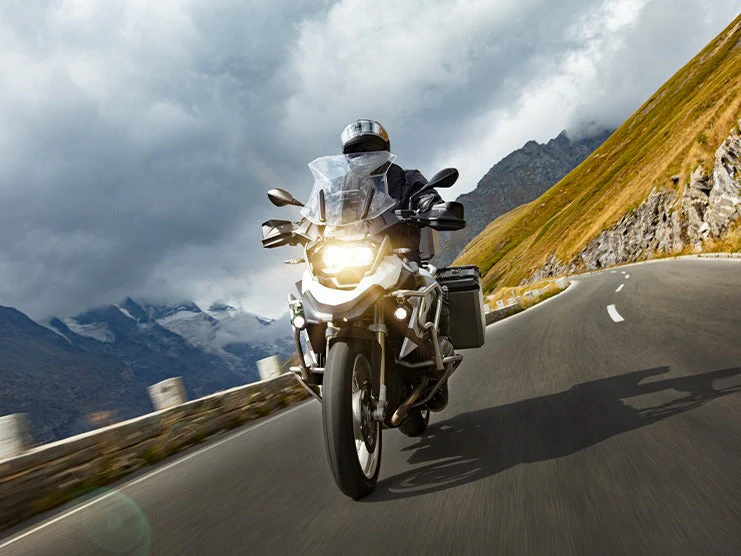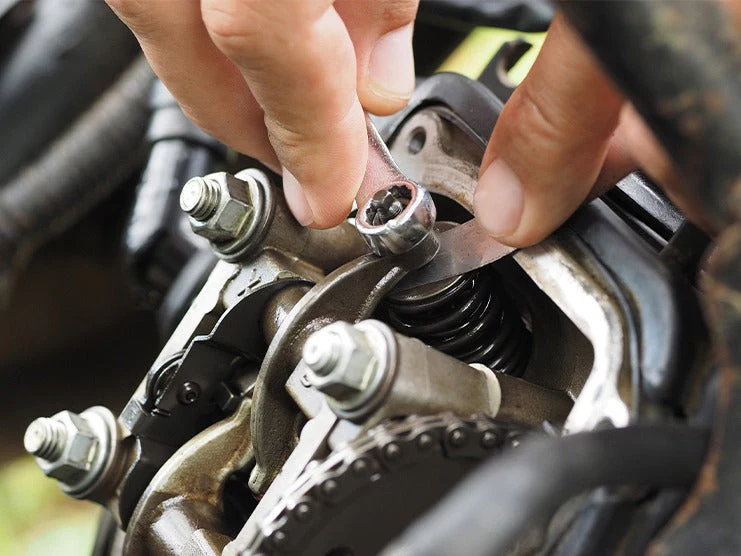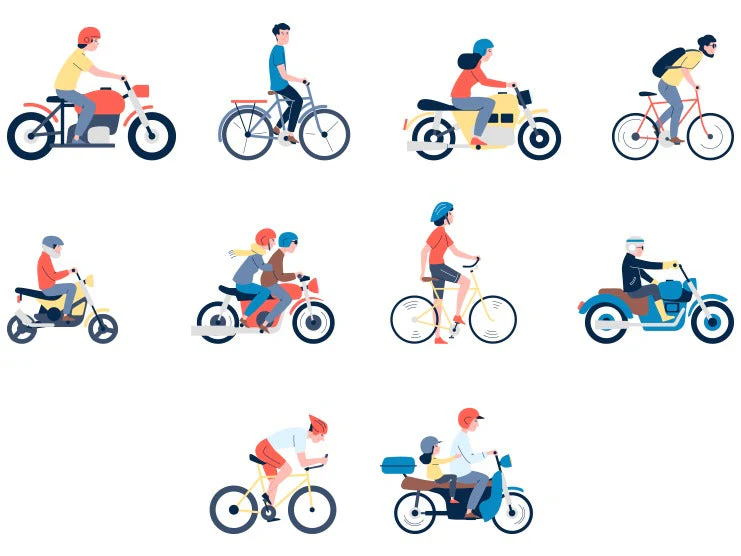Motorcycle riding comes with the risk of accidents and severe injuries. Motorcyclophobia, or a fear of riding a motorcycle, is a common problem among aspiring riders. Most novices are afraid of riding their bikes on highways because they are intimidated by the multiple lanes, high-speed limits, and heavy traffic.
This article discusses how to overcome the fears of riding a motorcycle on a highway.
Table of Content

1. Common Fears of Riding a Motorcycle on Highway
1.1 Fear of Turning Corners
Corners at the entrance, exit, or along highways may differ in length and angle. When entering a corner, riders have to determine the right gear and speed, examine the surface of the road, evaluate traffic, etc. When riding at a higher speed, your brain is forced to calculate how to maneuver faster.
Tight Corners
Tight corners have sharp angles that require you to lean far to the side while traveling slowly.
When turning tight corners, many riders cannot lean at a slow speed without falling over. Riders often lack confidence when approaching tight corners, being too concerned about the motorbike falling or stopping to focus on the road.
U-Turn
Leaning your motorcycle when making a U-turn doesn’t feel comfortable, some riders try doing this standing on the pegs. However, trying to keep your body in an upright position while leaning on the motorcycle can make riding uncomfortable.
Falling or Stalling
Trying to turn a corner while gradually slowing down can cause your motorcycle to fall over or stall, bringing your motorcycle to a stop.
How to Overcome the Fear of Turning Corners
Practice
Practicing frequently will help improve muscle memory and how to survey and calculate the best approach when turning a corner or making a U-turn.
Posture
Be mindful of your posture and try to keep your body relaxed while cornering.
Try doing the following:
- Breath deeply and steadily
- Look ahead to anticipate what is around the corner
- Hold the handlebars loosely and avoid tightening your grip
Concentrate
Rather than concentrate on how far you should lean, focus instead on timing when to lean, staying in your current lane, and steadily applying the throttle. When you start concentrating on these factors, you’ll have enough confidence to make a turn without any fear.
1.2 Fear of Braking
Many motorcycle riders are afraid of applying the brakes too hard on highways since it could cause them to hit another vehicle or cause the motorcycle to fall over. Hard braking can cause you to lose control of your motorcycle or cause the tires to lock up.
How to Overcome the Fear of Braking
Practice
Whether your motorcycle is equipped with ABS or not, it is best to practice often in a parking lot or any street with no traffic.
Practicing how to brake on time to gradually reduce speed will help improve your muscle memory. Every time you practice, try to squeeze the brake handle a little harder. If you hear the front tire wiggle, this indicates you are on the verge of locking the front tire. If you feel the front wheel lock, try to relax and loosen your hold on the front brake handle.
If you need to stop suddenly, it is best to pull the clutch and avoid applying the rear brake to keep you from falling off.
Braking Drills
Practicing braking drills can help better prepare you for sudden situations.
- Locate an open parking lot with a paved surface free of debris.
- Ride your motorbike between 5 to 8 mph before coming to a controlled stop.
- Each time you come to a controlled stop, gradually increase the pressure on the brake. Over time, you will eventually be able to make controlled hard stops.
- If you need to make a hard stop, make sure you are traveling over 8 mph.
1.3 Fear of Wet Roads
Almost every rider is anxious riding on wet roads since they are slippery and can increase the risk of getting into an accident. Rain can cause grit, oil, etc. to come to the surface, making roads even more slippery. When it is raining, it can become more difficult to identify slick spots on the road.
How to Overcome the Fear of Wet Roads
Tires
Try to find tires that offer the best traction on wet roads. You can try out tires from different brands or ask other motorcyclists for advice on the tires best suited for wet road conditions. These tires will increase traction by repelling water on the contact patches and reducing hydroplaning.
Ride Over Other Vehicle's Tracks
To avoid riding on slick spots, try to follow the tracks of the vehicles ahead of you since these areas will have less accumulated oil and grease.
1.4 Fear of Riding in the Dark
Riding a motorcycle in the dark can be stressful since traveling in areas with few or no braking lights, headlights, and streetlamps can reduce your vision.
How to Overcome the Fear of Riding in the Dark
- Slow down to give yourself more reaction time and allow you to scan more of your surroundings.
- Scan the road often for hazards, even more so than during the day.
- Check all the lights on your motorcycle to make sure they are working properly and adjust the headlight.
- Be on the lookout for any animals that come out at night and may try to cross the road.
1.5 Fear of Debris on the Highway
Some highways may be covered in oil, gravel, sand, and pebbles. They can cause your tires to slip and could result in a serious accident. Do not focus on looking in front of the front wheel, doing this can endanger your ride, you’ll continuously be surprised by what happens on the road, and it will result in increasing your feeling of fear.
How to Overcome the Fear of Debris on the Highway
Look Ahead on the Road
Train yourself to constantly look ahead while checking the surface of the road. It is a matter of practicing again and again until it comes automatically.
If you are willing, you can take riding courses to teach you how to ride safely on rough terrain. Practice riding slowly in a straight line and grip the handlebars loosely. If you tighten the handlebars you hinder the movement of your motorcycle, hold the handlebar loosely and give your bike the opportunity to find its own way.
1.6 Fear of Riding After an Accident
It can be difficult to get back on a motorcycle shortly after being in an accident. However, it is best to try to get back on a motorbike as soon as possible since it becomes harder to get used to riding a bike again the longer you wait.
- Give yourself time to recover following an accident, don’t force yourself to immediately start riding again.
- If you think that you were responsible for a recent accident because you were not paying attention, learn from the experience and try to practice safer riding. Don’t get insecure about your capabilities, focus on your learning and practice more.
2. Tips to Overcome the Fear of Riding a Motorcycle on Highway
2.1 Take a Motorcycle Riding Course
A motorcycle riding course will teach you the basics of operating a motorcycle. Having a basic understanding of riding techniques will ensure a smoother riding experience. You’ll gain enough confidence to take your two-wheeler on the highways fearlessly and safely.
2.2 Get Proper Motorcycle Gear
Wearing the right riding gear is mandatory and will reduce the risk of suffering severe or fatal injuries.
2.3 Learn How to Stay Calm
Keeping calm while riding on a highway is the best way to overcome your fear. Control your breathing, stop your bike, and take a few deep, slow breaths.
2.4 Be Willing to Learn More
Never think that you’ve learned everything about riding even if you are an experienced rider. Riding a motorcycle is a constant learning process. Since you never know when you will learn something new, always be open to learning new riding tips.
2.5 Practice
Choose a place with little to no traffic to practice and improve your riding skills. Constantly practicing how to brake, accelerate, signal, change gears, and operate controls.
3. Last Words
Many motorcyclists are afraid of riding a motorcycle on highways due to heavy traffic and multiple lanes. Many riders are afraid of braking, cornering, wet roads, riding in the dark, road hazards, and riding after an accident. Practicing repeatedly, taking a motorcycle riding course, and learning how to stay calm can help you overcome your fear of riding a motorcycle on a highway. There are a variety of aftermarket parts available at Viking Bags, including sissy bars, crash bars, fairings, seats, luggage racks, and backrests.













Leave a comment
All comments are moderated before being published.
This site is protected by hCaptcha and the hCaptcha Privacy Policy and Terms of Service apply.